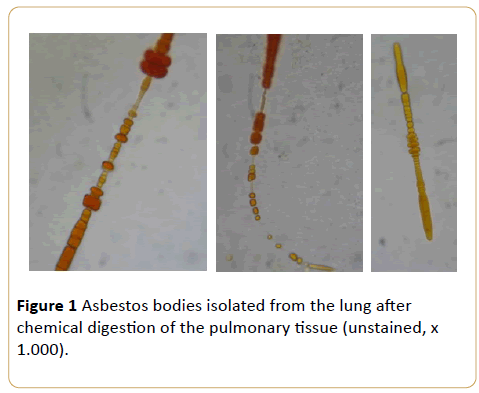Claudio Bianchi*
Center for the Study of Environmental Cancer, Italian League against Cancer, Hospital of Monfalcone, 34074, Monfalcone, Italy
- *Corresponding Author:
- Claudio Bianchi
Center for the Study of Environmental Cancer
Italian League against Cancer
Hospital of Monfalcone, 34074, Monfalcone, Italy
Tel: +39-0481-44007
E-mail: legatumori1@interfree.it
Received date: 23 January 2017; Accepted date: 25 January 2017; Published date: 31 January 2017
Citation: Bianchi C. Asbestos Bodies. Arch Can Res. 2017, 5: 1. doi:10.21767/2254-6081.1000129
The core of the body is a colourless need-like fiber of asbestos. The host tissue uncompletely embeds the body with material composed by iron and protein. This is golden yellow. Asbestos bodies do not represent all asbestos presence in the lung. In fact, high number of asbestos fibers remain unembedded. Nevertheless, asbestos bodies represent a very precious marker that documents a previous asbestos exposure.
Brief Report
The core of the body is a colourless need-like fiber of
asbestos. The host tissue uncompletely embeds the body with
material composed by iron and protein. This is golden yellow.
Asbestos bodies do not represent all asbestos presence in the
lung. In fact, high number of asbestos fibers remain
unembedded. Nevertheless, asbestos bodies represent a very
precious marker that documents a previous asbestos exposure
(Figure 1).
Figure 1: Asbestos bodies isolated from the lung after chemical digestion of the pulmonary tissue (unstained, x
1.000).
Asbestos bodies are extremely diffused in the industrial
world. Necropsy-based studies conducted in the 1970s in
various countries of the world showed that the bodies were
detectable in all people living in large cities.
Obviously, the body burdens show a wide variation after the
patient history: from few bodies per gram of dried tissue to
even 10,000,000 bodies. This means that asbestos bodies may
offer information not only on the existence of a previous
asbestos exposure, but also about its intensity.
Although asbestos is well recognized as a potent
carcinogenic agent, its use continues in a large majority of the
world, corresponding to about 80% of the general population.
Therefore, asbestos continues to represent a major health
problem.
18195






